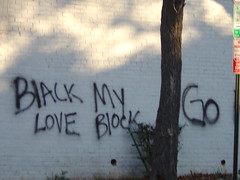Quote of the day (murder - crime)
Courtland Milloy's column today, "Violent Robberies Make It Hard to Ignore D.C.'s Vicious Side," is particularly good with sound analysis. From the article:
The District has the largest disparity between rich and poor of any city in the country; the well-to-do may be enjoying their wealth too much to really notice. But the geographic distance between the two groups could hardly be smaller, and now there's apparently more resentment to go with the proximity.
 Contested space graffiti. Taken near Howard University. Photo by Beth Lawrence, 2005.
Contested space graffiti. Taken near Howard University. Photo by Beth Lawrence, 2005.This gets to the point I make all the time about contested spaces. See
-- Revitalizing places that are contested spaces
-- Historic preservation in low income neighborhoods
-- More on unaffordable housing (Yes, gentrification is part of the program in DC)
-- Community Preservation and Development
-- One reason why I think the Gentrification word is over- and mis-used
-- Does change mean gentrification? Categorically?.
But in any case, I recommend reading Courtland Milloy's full column, if you haven't already.
I think the issue is that in a market economy, particularly in a hyper-real estate market, extraordinary measures are required to preserve housing for people of lower-incomes, otherwise constant upward pressure on prices and rents and property taxes will displace all but those with the most money and assets. (See Remaking New York: Primitive Globalization and the Politics of Urban Community and Super-gentrification: the case of Brooklyn Heights, New York City.)
And then there is the issue of working to ensure that people can participate in the market economy. There was an article the other day about a Council hearing where the representatives of the employers kept making the point that most DC residents that come their way, applying for jobs, aren't qualified.
The text, Community Economic Development Handbook, is about what I call second generation community development. The first generation focused on housing development, and then after 20+ years discovered that the communities were still distressed. You have to rebuild the local economies, on a neighborhood-by-neighborhood basis, as well as city-wide, and redevelop demand for housing, retail, etc.
I am going to snag something I wrote in a comment on another entry.
The solution is to rebuild communities from the ground up, and I don't mean physically, I mean socially and culturally. That means providing great municipal services, including schools.
I keep writing about schools, not because I want to, but because the level of discourse about them in DC is so pathetic.
If we had great schools, we would break the cycle of poverty. If we had year-round schooling, we could help reduce the crime uptick in the summer, but we could also provide more and better schooling and opportunities, to give our residents even more advantages.
One way to start, to begin to break the poverty cycle, is to link parents to the schooling of their children. I write about this all the time, having been greatly influenced by the positive deviance approach, after reading about incredible success in Brazil.
This is the "ungood" idea about this that I submitted to the DC Appleseed contest:
Build a community of learning centered around the schools through family learning contracts
Until we have families and peer groups that support learning, we're not going to be able to improve outcomes. School systems can only do so much.
There is an interesting article about "positive deviance" in the May 2005 issue of the Harvard Business Review. It includes a case study about the schools in an impoverished state in Brazil where the teachers hadn't been paid in 6 months, and the test results for the entire province were about 50% worse than the national average.
Yet some schools were amongst the highest performers in the country.
It turned out this occurred because these schools engaged the entire family into the process of achieving academic success by creating family learning contracts. Parents were also motivated to do this because they were often illiterate, and literate children were able to help connect the family to government services by being able to read, write, and translate information about the programs.
This provided an additional sweetener, making the whole family committed to and engaged in the classroom success of their child(ren).
This idea of the family learning contract has a lot of relevance to urban school systems. Schools only have children for 6-8 hours/day. The rest of the time they are under the influence of peers, parents, and other members of the community. We can begin to right this process by getting the whole family committed to and participating in the learning life of their children.
Index Keywords: urban-revitalization; poverty



0 Comments:
Post a Comment
<< Home